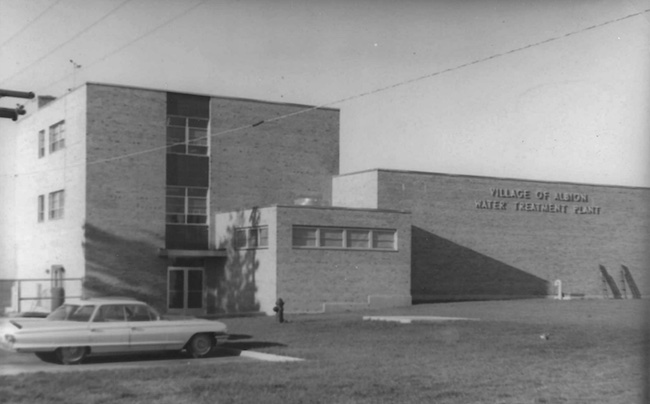Village of Albion opened new water plant 60 years ago by Lake Ontario
Albion built plant after years of complaints of foul-smelling water from reservoir, Erie Canal

This photograph shows the Village of Albion Water Treatment Plant as it appeared at the dedication ceremony in 1963.
By Catherine Cooper, Orleans County Historian
Illuminating Orleans, Vol. 2, No. 38
ALBION – It was announced recently that the Village of Albion had approved the construction of a Fluoridation Building at the Albion Water Treatment Plant in Carlton, at a cost of $388,000.
The Water Treatment Plant has now been in operation for 60 years. The Medina Daily Journal announced that Arthur Leavitt, State Comptroller, would tour the “new water treatment plant at Lake Ontario and the booster station at Five Corners” on July 30, 1962 “accompanied by village officials and other interested civic leaders.” The plant, which is located on Wilson Road, was formally dedicated on September 24, 1963.
Albion voters had approved the $1,760,000 bond for the construction of the plant by a 4-1 majority on March 15, 1960. At issue was the source of water supply: the bond proposal favored the establishment of a new water system for the village, and of sourcing water from Lake Ontario.
Those who opposed the 1960 bond proposition claimed that the proposed plan was too expensive, an unfair burden on future generations and that all of the possible alternatives had not been investigated thoroughly.
The sourcing of Albion’s water supply had been a contentious issue for many years. At first, water was supplied from wells dug by the Albion Water Works Company in 1897. The village bought this private company in 1914 and drilled additional wells. This was supplemented by water from the Otter Creek reservoir, southeast of the village.
However, these sources proved inadequate, and the village frequently relied on water drawn from Erie Canal. This was occasional at first, but by 1959, the village was using three intakes from the Canal on a regular basis, even though this has been deemed “an unsuitable source” as early as 1914 by the New York State Conservation Commission. The State Department of Health disapproved the use of canal water as an auxiliary source and set a succession of deadlines – 1946, 1949, 1953, 1955 and 1958 – for the discontinuation of its use. Concerned by continuing use of potentially dangerous water and frustrated by the Village Board’s delays in producing a plan to find another source of water, it was reported that the State would resort to a court injunction to stop the use of Canal water.
The Buffalo engineering firm of Nussbaumer, Clarke and Valzy was responsible for the project. A report noted in the Buffalo News of February 16, 1961, highlighted the urgent necessity for completion of the new plant. Albion Mayor John D. Robinson had received hundreds of complaints about the taste and odor of the drinking water.
People complained that it tasted like iodine, gasoline, or paint and that when boiled, an oily scum rose to the top. Apparently, the Eagle Harbor Reservoir, which had been used for Albion’s winter water supply, was dry for the first time in years. A protracted cold spell caused the formation of ice on the canal, and only three feet of water was available. Assemblyman Alonzo L. Waters assured the Mayor that the state would raise the level of water in the canal to alleviate the problem. A representative of the Health Department stated that the water was safe to drink but unpalatable.
Mayor Robinson acted as master of ceremonies at the dedication of the new plant on September 24, 1963.The raising of the flag was performed by the Color Guard, Sheret Post, American Legion, under Commander Sam Navarra. The Albion Central School Band, Moses Sherman conducting, played the National Anthem and God Bless America. The invocation was given by Msgr. Felix F. McCabe, pastor of St. Joseph’s Church, and the benediction by Rev. Herbert W. H. Corey, pastor of the First Methodist Church, both of Albion.
In his address, Lieutenant Governor Malcolm Wilson praised the village for its vision and foresight in building the new water system. It now supplies the village and the towns of Albion, Barre, Carlton, Gaines and Murray.









































































